RM Acquisition 01002A Truck Information Terminal User Manual HD100 User Manualx
RM Acquisition LLC Truck Information Terminal HD100 User Manualx
User.Manual Rev.2
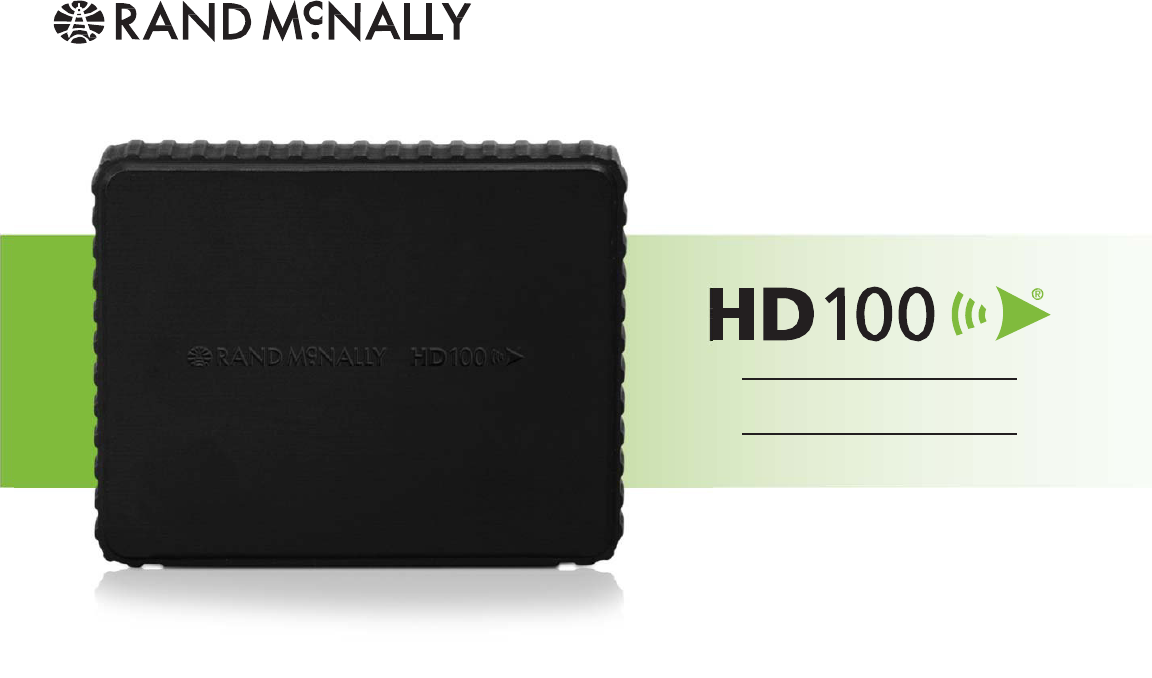
User Manual
2
HD 100 Use
r
Manual

Support
Call us:
1-800-641-RAND (7263)
E-
ail us:
fleetsupport@randmcnally.com
Write to us:
Rand McNally
Attn: HD 100
®
Customer Support
106 Hi-Lane
Richmond, KY 40475
Safe Driving Practices:
This product is powered by lead-acid battery
Always use your best judgment, exercise caution and common sense
,Don’t Short Circuit.
when the vehicle is in motion. Do not become distracted by the device
while driving. Minimize the amount of time spent looking at the device
while driving and use voice prompts when possible.
When using the device, maintain a distance of
Do not input destinations, change settings, or access any functions
20cm from the body to ensure compliance with
requiring prolonged use of the device controls while driving. Pull over
in
RF exposure requirements.
asafeandlegalmannerbeforeattemptingsuchoperations.
2
HD 100 Use
r
Manual
HD 100 User Manual
3
FCC Compliance Statement
This device complies with part 15 of the FCC rules. to the following two
conditions: (1) this device may not cause harmful Operation is subject
interference, and (2) this device must accept any interference received,
including interference that may cause undesired operation.
This equipment has been tested and found to comply with the limits for a
Class B digital device, pursuant to part 15 of the FCC rules. These limits
are designed to provide reasonable protection against harmful interference
in a residential installation. This equipment generates, uses, and can radiate
radio frequency energy and may cause harmful interference to radio
communications if not installed and used in accordance with the instructions.
However, there is no guarantee that interference will not occur in a particular
installation. If this equipment does cause harmful interference to radio or
television reception, which can be determined by turning the equipment off
and on, the user is encouraged to try to correct the interference by one of the
following measures:
•
Reorient or relocate the receiving antenna.
•
Increase the separation between the equipment and the receiver.
•
Connect the equipment into an outlet that is on a different
circuit from the telematics unit.
•
Consult the dealer or an experienced radio/TV technician for help.
NOTE: The manufacturer is not responsible for any radio or TV
interference caused by unauthorized modifications or
changes to this equipment. Such modifications or
changes could void the user’s authority to operate the
equipment.

4
HD 100 Use
r
Manual
Table of Contents
Activating Your HD 100 for the First Time
...................................
5
Download Dock
.......................................................................
5
Connect HD 100
......................................................................
6
Activate Service Plan
.................................................................
6
Configure Account Settings
.........................................................
6
Connect TND
™
720
...................................................................
6
Installing Your HD 100
...............................................................
7
Installation Kit
.........................................................................
7
Installation Instructions
............................................................
7-8
Alternative Install Options
..........................................................
8
Quick Diagnostics
.....................................................................
8
Troubleshooting
..................................................................
9-11
Accessing the Connect Web Portal
.............................................
12
Log On
.................................................................................
12
Feature Overview
................................................................
13-14
Using the HD 100 Software
......................................................
15
Getting Started
.......................................................................
15
Power On
..........................................................................
15
Log On
.............................................................................
15
Warning Screen
...................................................................
16
On-screen Keyboard
.................................................................
17
Status Bar
..........................................................................
18
Screen Calibration
................................................................
19
HD 100 Home Menu
...............................................................
20
Home Menu Safe-driving Screen
..............................................
21
HD 100 Mail ......................................................................................... 22
Inbox ............................................................................................... 23
Open Message .......................................................................................... 24
Outbox ............................................................................................ 25
Send Messages ........................................................................................... 26
Options ............................................................................................ 27
Mail Safe-driving Screen ........................................................................ 27
HD 100 Hours of Service ............................................................................ 28
Summary .......................................................................................... 29-30
Duty Status ....................................................................................... 31-35
Logs .................................................................................................... 36-38
DVIR .......................................................................................... 39-42
Options ....................................................................................... 43-45
Company ......................................................................................... 46
HOS Safe-driving Screen ....................................................................... 47
HD 100 SysInfo ........................................................................................... 48
Settings ........................................................................................... 49
Info ......................................................................................................... 49
Diagnostics ...................................................................................... 5 0
SysInfo Safe-driving Screen ................................................................... 51
HD 100 Stats .............................................................................................. 52
Driver Performance ................................................................................ 53
Fault Codes .................................................................................................. 54
Help & Customer Support Information
.......................................
55
User Documentation .................................................................................. 55
Additional Resources ............................................................................55
Customer Support ...................................................................................... 56

6
HD 100 Use
r
Manual
Activating Your HD 100 for the First Time
NOTE:
You need a TND
™
720 device to use your HD 100.
Activating your HD 100 will require you to plug both your
HD 100 and your TND
™
720 into your computer.
Download the Dock
If you do not already have the Rand McNally Dock downloaded, go to
randmcnally.com/HD100dock
and download and install the Dock.
The Rand McNally Dock is an essential part of your Rand McNally GPS
device. It provides you with free software upgrades and access to map
updates. Through the Dock, you can also access the user guide for
your device and send feedback to Rand McNally via “Tell Rand”.
To get started, click the link below to download the installation file.
Save the file to your desktop or another folder on your computer, then
select the file and click “run” to begin the installation. If the download
does not start, please adjust the settings on your Internet browser
and/or anti-virus software.
Please connect your IntelliRoute
®
TND
™
to your computer to begin
using the Rand McNally Dock.

HD 100 Use
r
Manual
7
Activating Your HD 100 for the First Time
Connect HD 100
Connect your HD 100 device to your computer with the
provided USB cable.
The Dock will then walk you through step by step to activate
your service plan, configure your account settings and pair
your HD 100 and TND™ 720.
Activate Service Plan
Select and purchase the HD 100 service plan that works for your
needs. The Dock will display information on these service plans.
Configure Account Settings
The Dock will walk you through the essential settings and account
information you need to configure so you can use your HD 100 device
out of the box.
NOTE:
For more information on additional settings to further
customize your user experience, log in to the portal and click the
Help tab, then select Connect Help. The Connect web portal User
Manual will appear in a new tab in your browser. Click on the
Management section to view all account settings available to you.
Pair HD 100 with TND
™
720
You will be instructed to unplug your HD 100 first, then plug in your
TND
™
720 device. The Dock will then pair these two devices, enabling
them to work together once you install them in your truck.

8
HD 100 Use
r
Manual
Installing Your HD 100
Installing your HD 100 can take as little as 10 minutes. Install
instructions are provided here, as well as quick diagnostic
information so you can make sure your device is working correctly.
Installation Kit
HD 100 Device HD 100 Get Started Card
9-pin Power Cable HD 100 User Manual
USB Cable Rand McNally Hours of Service Visor Card
Adhesive Velcro Strips Cable Ties
Installation Instructions
1.
Locate the truck’s diagnostic port. Remove the plug on the
diagnostic port, connect the cable, and lock the collar and place.
2.
Route cable from the diagnostic port to the area where you
would like the HD 100 to be mounted, making sure to place it
away from any vents and where it won’t interfere with driver
(the right-most corner of the dash is usually an ideal area to
place the device), tucking the cable in the space between the
windshield and the dash.
3.
Connect the device to the cable. You may choose to position the
device so the LEDs on the front of your device face away from
you so as to not distract while driving.
4.
Wipe the dash area where you would like to place the HD 100
with the alcohol-based wipe, making sure the surface dries
thoroughly. Peel the protective layer off one side of the Velcro
strips and place on the bottom of the HD 100 device, then peel
the other protective layer and place the device on your dash in
the desired location, pressing firmly to secure it to the
dash surface.
5.
Once the HD 100 is installed and connected to vehicle with
the cable, turn your truck on to accessory mode (the mode you
use to operate your radio and A/C without turning the ignition
on fully). The four lights on the side of the device should
illuminate. Check the colored LEDs on the side of your HD 100
to ensure the device is connected and running properly
(Power:
Red, Wi-Fi: Amber, Cell: Green, Jbus: Blue).
6.
Turn on your TND
™
720 device. You will first see the
IntelliRoute
®
software Home Menu. Click the HD 100 button
on this screen.

HD 100 Use
r
Manual
9
Installing Your HD 100
7.
Once the HD 100 software loads, log onto the HD 100 software
by entering the Driver ID you created when activating your
device through the Rand McNally Dock. NOTE: you can also
refer to the Rand McNally HD 100 Activation email you received
after you completed this process. Your log-in information is in
this email for your records.
NOTE:
Do not cover the device or place anything over it that may
disable the GPS signal.
Alternative Installation Options
Contact Rand McNally Customer Support at
1-800-641-RAND (7263)
or
fleetsupport@randmcnally.com
for more information on
alternative installation options.
Accessories and parts for alternative installations can also be
purchased at
randmcnally.com/fleetaccessories
.
•
9 to 6-pin Cable Adapter
•
Drill-in Dash Mount Base
Quick Diagnostics
Check the colored LEDs on the side of your HD 100 to ensure the
device is connected and running properly (Power: Red, Wi-Fi: Amber,
Cell: Green, Jbus: Blue).
Verify GPS Communication
Select SysInfo icon from Home Menu. Select Diagnostics, then the GPS
tab. Verify GPS status is good and that there are values in the Latitude
and Longitude fields.
Verify J1708/1939 Communication
Drive the truck at least .2 miles. Select the SysInfo icon from Home
Menu. Select Diagnostics, then the J-Bus tab. Verify that there is an
odometer value in the Eng. odom. field. Then go back to the Home
Menu and select Stats. icon, then the Driver Performance tab. Verify
there is a value in the Miles field on the second line in the first column.
(Enterprise Plan only)
Send Test Message
Select the Mail icon on the Home Menu and tap Send. Type message
subject and message text and tap Send in the upper left hand corner.
Make sure message indicator changes from X to a green check mark.
(Basic & Enterprise Plan only)

Installing Your HD 100
10
HD 100 Use
r
Manual
Power
On
– Application up and running
Off
– Power Off
Fast Flash
– System error
Slow Flash
– Bootloader running
Display
On
– VNC client is connected to VNC server
Off
– Wi-Fi modem is off
Fast Flash
– Wi-Fi error
Slow Flash
– Wi-Fi client connected
ATTN
On
– Attention necessary by Driver
Off
– No attention necessary
Fast Flash
– Not supported
Slow Flash
– Not supported
JBus
On
– Data received from at least one JBus
Off
– No data received from any Jbus
Fast Flash
– JBus error (iBridge not responding, etc.)
Slow Flash
– Missing data from JBus
Troubleshooting
The LEDs on the side of the HD 100 illuminate to indicate that the
device is connected and running properly. If one or more of the four
lights are not illuminated, meaning they are either off or flashing,
there may be an error.

Installing Your HD 100
HD 100 Use
r
Manual
11
No power or intermittent power loss:
Check power connection
Ensure that the cable is secured to the HD 100 device. Reestablish the
cable connections by unplugging them, then plugging them back in.
Make sure locking collar is turned. Then check that the red LED light is
on, which indicates the device is powered on.
Check communications
Check that the colored LEDs on the front of your HD 100 are
illuminated which indicate the device is connected and running
properly (Wi-Fi: Amber, Cell: Green, Jbus: Blue).
Unable to send and receive messages:
(Basic & Enterprise plan only)
Check communications
Check that the colored LEDs on the front of your HD 100 are
illuminated which indicate the device is connected and running
properly (Wi-Fi: Amber, Cell: Green, Jbus: Blue).
Restart the device
Restart the device by first logging off on your target device, then
pressing the Power button. Then disconnect the cable from your
HD 100 device. This will cause the device to reset and reconnect.
Unable to connect Cell or Wi-Fi
®
:
Restart the device
Restart the device by first logging off on your target device, then
pressing the Power button. Then disconnect the cable from your
HD 100 device. This will cause the device to reset and reconnect.
Check communications
Move the truck to ensure that the issue is not signal interference.
Nothing appears on device:
Make sure your target device is charged and powered on.
Check communications
Move the truck to ensure that the issue is not signal interference.

Installing Your HD 100
12
HD 100 Use
r
Manual
Screen not responding:
Check power connection
Ensure that the cable is secured to the HD 100 device. Reestablish the
cable connections by unplugging them, then plugging them back in.
Make sure locking collar is turned. Then check that the red LED light is
on, which indicates the device is powered on.
Hold down the Home button on the bottom right corner of your device
for 5 seconds. This will cause the Calibration screen to come up.
Follow the instructions provided on the screen.
Restart the device
Restart the device by first logging off on your target device, then
pressing the Power button. Then disconnect the cable from your
HD 100 device. This will cause the device to reset and reconnect.
JBus not responding:
Make sure truck ignition is on
Restart the engine
Restart the device
Restart the device by first logging off on your target device, then
pressing the Power button. Then disconnect the cable from your
HD 100 device. This will cause the device to reset and reconnect.

HD 100 Use
r
Manual
13
Accessing the Connect Web Portal
The Rand McNally Connect web portal is the web-based compliance
reporting & vehicle performance tool that allows you to view the Hours
of Service and vehicle performance data that your HD 100 collects.
Sign onto the portal on your computer to view your driver logs in
various different reports. Log data in the portal available for six months
in the portal, per the U.S. Department of Transportation’s requirement.
NOTE:
You do not have to log onto the Connect web portal before
you can use your HD 100 in your truck the first time. You may refer
to the portal when you would like to view your driver log history.
Log On
Sign on to the Rand McNally Connect web portal on your computer
to view your HOS logs and performance*.
To log onto the Connect web portal, go to connect.randmcnally.com.
Enter the email and password that you created during the HD 100
Activation process on the Dock (you can also reference the HD 100
Activation email you should have received after completing this process).

14
HD 100 Use
r
Manual
Accessing the Connect Web Portal
Feature Overview
Depending upon the service plan you select, you will be able to
access various features in the Connect web portal. The table
below summarizes these features and which service plans include
each feature.
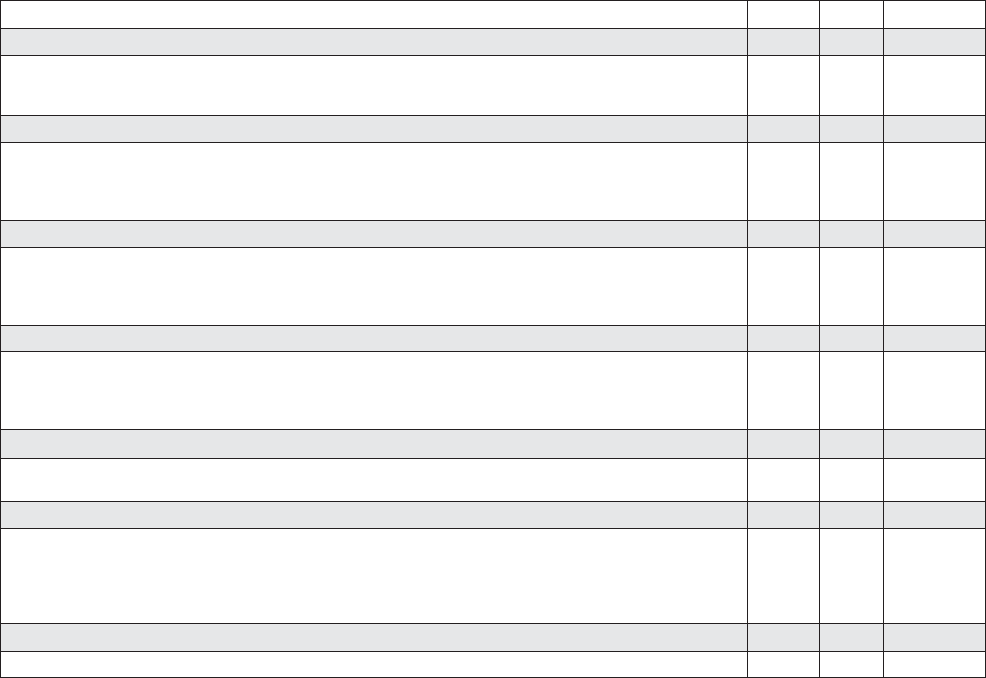
EOBR
Basic
Enterprise
Dashboard
The Dashboard is the home screen of the portal. It provides configurable gauges and charts for at-a-glance analysis of critical performance
metrics and trends. Each portal user can configure the data in their dashboard, with the ability to compare a specific driver or vehicle
group’s performance to the fleet’s overall performance.
X
Management
The Management application allows you to configure your Rand McNally Connect web portal experience so you and your organization can
maximize the value of its tracking, reporting and communication features. The Management application enables you to create and modify
driver log-in credentials and settings, portal user log-in credentials and settings, reporting groups, Portals well as perform all
other functions related to setting up your Rand McNally Connect web portal account.
X
X
X
Reports
The Reports application enables you to gain insight into your fleet’s performance so you can make sense of what happens on the road,
whether you want to run reports for one driver or vehicle, a particular group of drivers or vehicles, or your whole fleet. The Reports
application allows you to manage driver and vehicle performance data, fuel consumption by state, diagnostic fault codes for vehicle mainte-
nance purposes, and more.
Driver/
Vehicle
Info
Driver/
Vehicle
Info
All
Compliance
The Compliance application is the core of Rand McNally’s electronic driver logs solution, allowing you to keep all of your Hours of Service
and DVIR records accurate, up-to-date, and in one easy-to-access location for the required 6-month period, without the mistakes and
hassle of paper log books. The Compliance application enables you to manage HOS logs, DVIR entries, personal conveyance usage
(if enabled), and more.
X
X
X
Mail
The Mail application enables you to have constant communication with your drivers while they are out on the road. If you are an owner
operator, you can also configure your settings and use the Mail application to communicate with your team driver or spouse.
X
X
Mapping
The Mapping application enables you to view where your drivers and vehicles are at right now and how they’re performing, as well as
where they’ve traveled recently. The Mapping application features tools that can help you drill into how your drivers are progressing
through their day and how they’re performing, such as performance and Hours of Service alerts (in addition to the alerts that can be set up
via the Management > System Settings > Email Alerts section of the portal), as well as others that can help you find the closest truck to a
saved location, enabling you to find the vehicle best suited to pick up an available load from a customer location.
X
X
Help
Provides various instructional resources for your HD 100 device and the Connect web portal, such as user manuals and how-to videos.
X
X
X
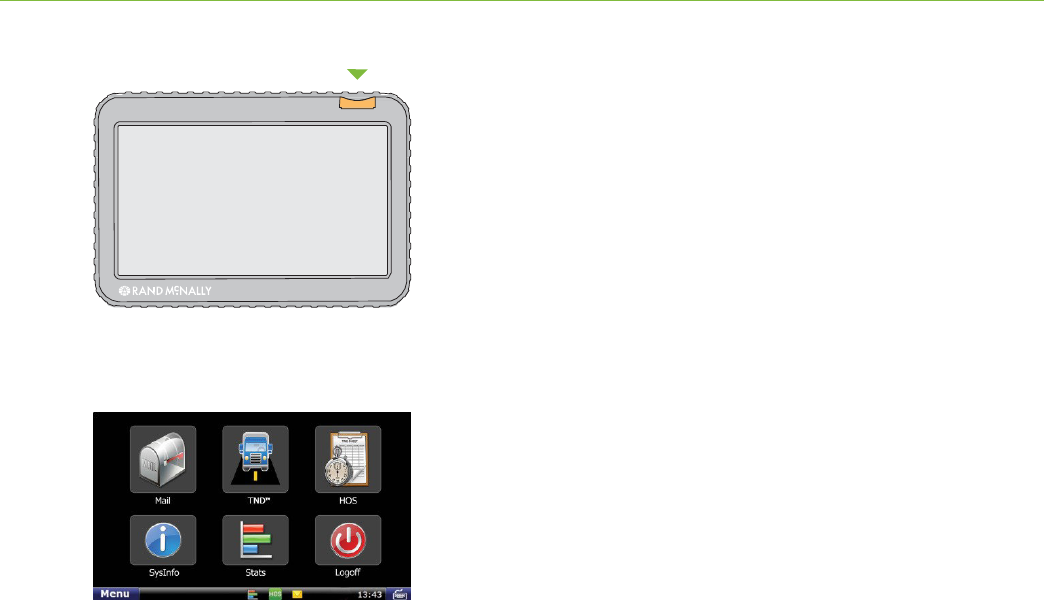
16
HD 100 Use
r
Manual
Getting Started
Exhibit 1.
TND
™
720 Power Button
Exhibit 2.
HD 100 Log On Screen
Power On
Turn on your truck to accessory mode (the mode you use to operate
your radio and A/C without turning on the ignition fully) to power on
your HD 100 device.
Press the Power button on your TND™ 720.
Log On
You will first see the IntelliRoute
®
software Home Menu.
Click the HD 100 button on this screen.
Once the HD 100 software loads, log onto the HD 100 software by
entering the Driver ID you created when activating your device
through the Rand McNally Dock. Tap Submit [Exhibit 2, (c)].
NOTE:
You can also refer to the Rand McNally HD 100 Activation
email you received after you completed this process. Your log-in
information is in this email for your records.
To go back to the IntelliRoute Home Menu, select the Back button.
NOTE:
To log off your HD 100, select the Logoff icon on the
HD 100 Home Menu.
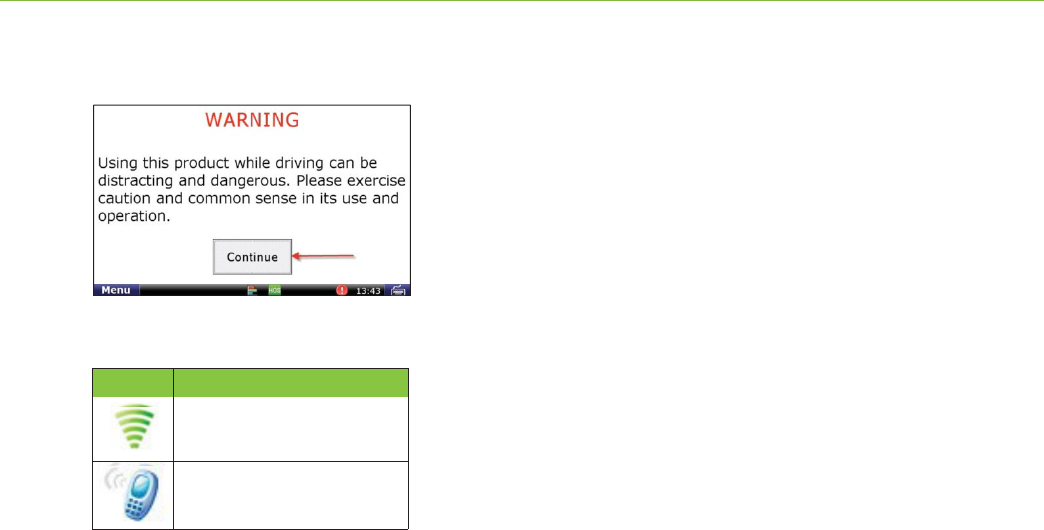
HD 100 Use
r
Manual
17
Icon
Definition
Wi-Fi
Cell
Getting Started
Exhibit 3.
Warning Screen
Warning Screen
The Warning Screen [Exhibit 3] reminds you that using
your HD 100 and TND
TM
720 while driving can be distracting.
Be cautious and wise.
Tap
Continue
[Exhibit 3] to complete the logon.
Communication Status
You must have a cell or Wi-Fi connection to log on
for the first time.
Locate the communication icon on the status bar. Icons and their
definitions are shown in the table to the left.
Tap the
keyboard
button in the bottom left corner of the keyboard
if you cannot view the status bar.
Note:
If you have a signal but still see errors (such as Invalid
Logon), refer to the Rand McNally HD 100 Activation email you
received after you completed the activation process through the
Dock. This email contains your Driver ID.

18
HD 100 Use
r
Manual
On-Screen Keyboard
(a)
Exhibit 4.
On-screen Keyboard
(f)
(b)
(c)
(d)
(e)
On-screen Keyboard
The HD 100 on-screen keyboard is quick to access and easy to use.
•
All controls are on the screen.
•
Large button faces fit your fingers.
To use the keyboard:
•
Tap the
keyboard
button [Exhibit 4, (e)] on the HD 100 status
bar to display the keyboard.
•
Tap the
ABC
or
!@#
buttons [Exhibit 4, (a)] to view
alphanumeric characters and symbols respectively. The arrow
button [Exhibit 4, (c)] on the right on the ABC screen allows you
to change between upper and lower-case letters.
•
Tap the
Delete
button [Exhibit 4, (b)] to erase a character.
•
Tap the
space bar
button to insert a space [Exhibit 4, (f)].
•
Tap
Enter
[Exhibit 4, (d)] to type on the next line.
•
Tap the
keyboard
button [Exhibit 4, (e)] again to hide
the keyboard.
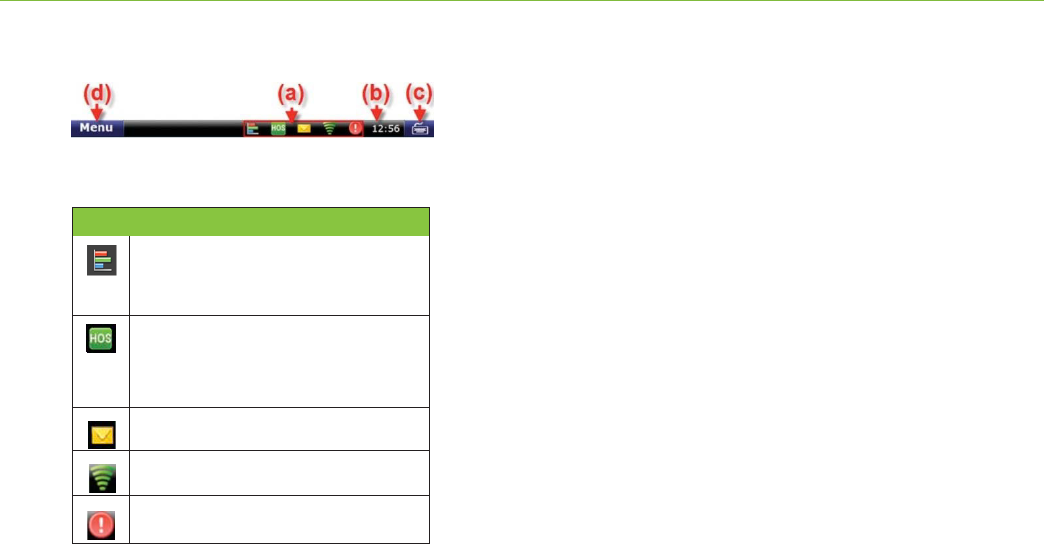
HD 100 Use
r
Manual
19
Icon Definition
Driver Peformance.
Balloon messages appear
over the icon to help you manage your performance.
Messages are related to metrics such as over idling
and speeding.
HOS.
The icon changes color according to your HOS
status. The icon is green when you are within acceptable
limits for each HOS status. The icon changes to yellow
when you are nearing violation status and to red when
you are in violation.
Mail.
The icon appears on the status bar when
you have unopened mail.
Communications.
The icon shows your communication
status (Wi-Fi, Cellular, No communication).
System message.
System alerts appear in
balloon messages over the icon.
On-Screen Keyboard
Exhibit 5.
Status Bar
Status Bar
The status bar remains visible at the bottom of every screen and
gives you access to current information about the HD 100.
Any status or alert icons are found on the status bar [Exhibit 5, (a)].
Icons and their definitions are shown in the table to the left.
The status bar also allows you to:
•
Check your terminal time [Exhibit 5, (b)].
•
Pull up the on-screen keyboard [Exhibit 5, (c)].
•
Return to the
Home Menu
[Exhibit 5, (d)].

20
HD 100 Use
r
Manual
Screen Calibration
Exhibit 6.
Calibrate Screen
Screen Calibration
As soon as you are logged in with the HD 100 software,
calibrate your screen.
Recalibrate from time to time, especially if the screen “slips”
when you touch it.
To calibrate your screen:
•
Press and hold the Home button
for 10 seconds.
Calibration starts once button is released.
•
Tap the center of the crosshairs as they appear on the calibration
screen [Exhibit 6]. There are four total.
-
Tap as close to the center of the crosshairs symbol
(+) as possible.
-
Use the same pressure you normally use when tapping
the screen
-
If you receive an error, try again.
NOTE:
Do NOT press and hold finger on the center of the
crosshairs. Just tap.
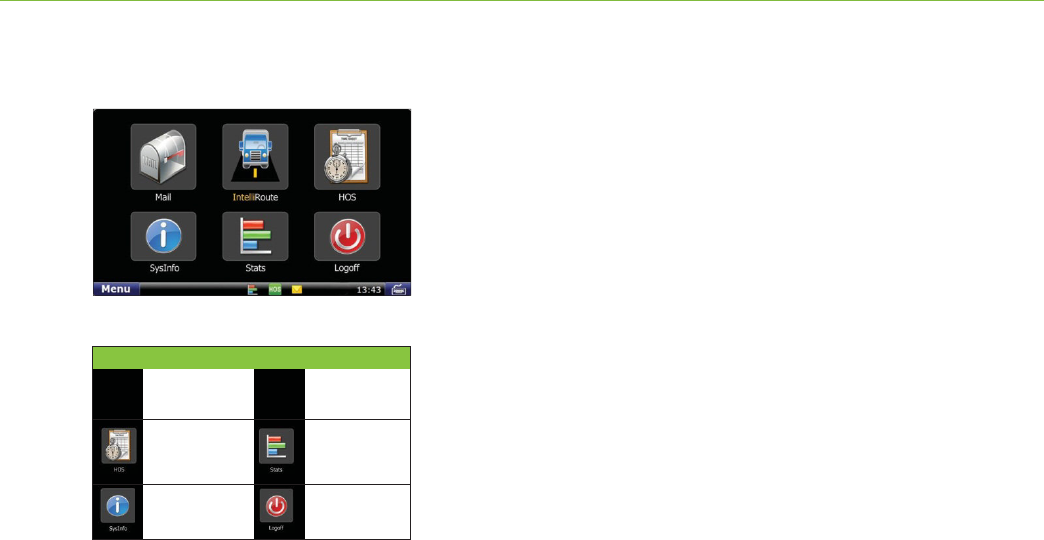
HD 100 Use
r
Manual
21
HD 100 Home Menu
Exhibit 7.
Home Menu Screen
Home Menu
The Home Menu [Exhibit 7] is the home screen of the HD 100
software. The applications available to you on the HD 100 are
identified by icons.
The icons on the Home Menu are explained in the table to the left.
•
Press the Menu button on the left of the status bar to return
to the Home Menu screen.
Icon Function Icon Function
View, listen
and respond
to messages.
Pinpoint location
and find routes.
Review, create
and send logs.
Access company
information.
View driver
perfomance stats.
Manage
settings, tasks and
communication.
Log off the
TNDTM 760.

22
HD 100 Use
r
Manual
HD 100 Home Menu
Exhibit 8.
Home Menu Safe-driving Screen
Home Menu Safe-driving Screen
Menu options are limited while you are driving. When your
truck is moving, the home menu safe-driving screen displays.
NOTE:
Functionality within the Mail, HOS and SysInfo
applications is simplified while you are driving.
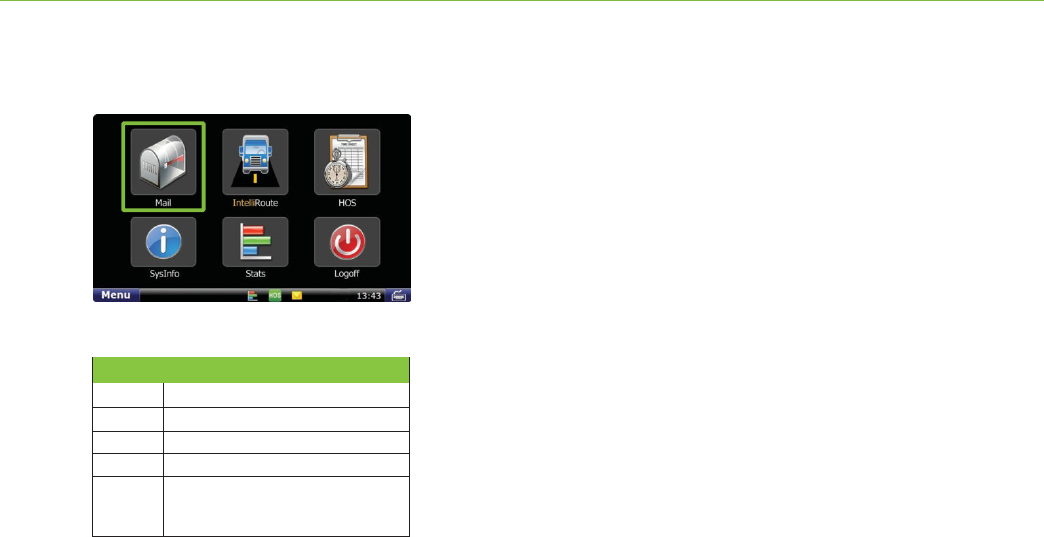
HD 100 Use
r
Manual
23
HD 100 Mail
Exhibit 9.
Mail Icon on Home Menu
Mail
Select the Mail icon on the Home Menu [Exhibit 9] to access
messages and send e-mails.
Mail opens to the Inbox tab. The tabs in Mail are explained
in the table to the left.
Tab Function
Inbox
Holds incoming messages.
Outbox
Holds outgoing messages.
Send
Allows you to send messages.
Work
Helps you process assignments.
Options
Displays your e-mail address
and allows you to manage
your e-mail contacts.

24
HD 100 Use
r
Manual
HD 100 Mail
Exhibit 10.
Inbox Tab
Inbox
All incoming messages appear in your Inbox [Exhibit 10]. Special
features of the Inbox tell you details about your messages.
Status information is clustered together [Exhibit 10, (a), (b) and (c)].
(a).
A blank space in this column means the message
has been opened. An envelope means it has not been opened.
(b).
A red exclamation point (
!
) icon means the
message is important. A paperclip ( ) icon means the
message
has an attachment.
(c).
When you are working in another Mail tab, an
envelope icon appears on the tab indicating that you have
an unopened message.
Other columns in the Inbox tell you more about your messages
[Exhibit 10, (d), (e) and (f)].
(d).
This column tells you who sent the message.
(e).
This column tells you the subject of the message.
(f).
This column tells you when the message arrived.
-
The time displays for messages that arrived on that current day
(based on your terminal time).
-
The date displays for messages that arrived on previous days.
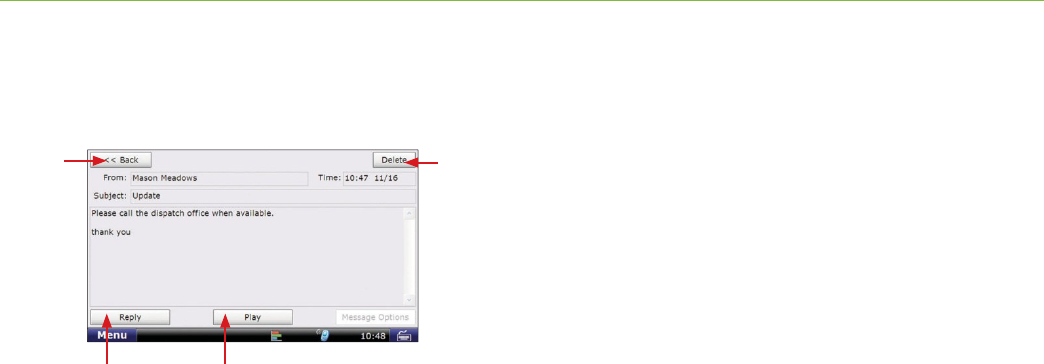
HD 100 Use
r
Manual
25
HD 100 Mail
(a)
Exhibit 11.
Open Message Screen
(c) (b)
(d)
Open Message
Select a message to open it [Exhibit 11].
Four action buttons are available once a message is open.
(a). Back
returns you to the Inbox.
(b). Play
lets you listen to the message.
(c). Reply
lets you send a response to the message.
(d). Delete
lets you delete the open message.
Your Inbox holds 200 messages. When more messages arrive,
the oldest messages in your Inbox are automatically deleted.
Personal E-mail Access
If you would like to use your in-cab device to message people other
than those who have a manager log-in to your Connect Web Portal
account, you can save up to 5 personal e-mail addresses to
communicate with while on the road.
Personal e-mails are color-coded blue in your Inbox so you can identify
them quickly. The color coding remains after the e-mail is read.
You can view your assigned e-mail address by selecting the
Options
tab on the Mail screen and tapping the
View E-mail Address
button.

26
HD 100 Use
r
Manual
HD 100 Mail
(a)
Exhibit 12.
Outbox Tab
(b) (c) (d)
Outbox
All outgoing messages appear in your Outbox [Exhibit 12]. Special
features of the Outbox tell you details about your messages.
Your Outbox holds 50 messages. When you have sent more than that,
the oldest messages in your Outbox are automatically deleted.
(a)
. A green check mark ( ) icon means the message has been
sent. An orange arrow ( ) icon means the message is waiting
to be sent. A red X ( ) icon means the message has not yet
been sent.
Other columns in the Outbox tell you more about your messages
[Exhibit 10, (b), (c) and (d)].
(b)
. This column tells you who received the message.
(c)
. This column tells you the subject of the message.
(d)
. This column tells you when the message arrived.
-
The
time
displays for messages that arrived on that current
day (based on your terminal time).
-
The
date
displays for messages that arrived on previous days.

HD 100 Use
r
Manual
27
HD 100 Mail
Exhibit 13.
Send Tab
Send Messages
You can send messages from the Send tab [Exhibit 13].
The on-screen keyboard [Exhibit 13, (a)] appears automatically when
you select the Send tab.
Drop-down boxes [Exhibit 13, (b)] make it easy for you to complete
the
To
and
Subject
fields.
•
The
To
field automatically selects
Dispatch
. The drop-down box
lists other saved contacts.
•
You can fill in the
Subject
field by using either the drop-down
list (if you want to send a form) or the on-screen keyboard
(if you want to send a message). If you choose a form from the
drop-down list, the screen displays the form in the message
field (the body of the screen).
When you are done, tap
Send
[Exhibit 13, (c)].
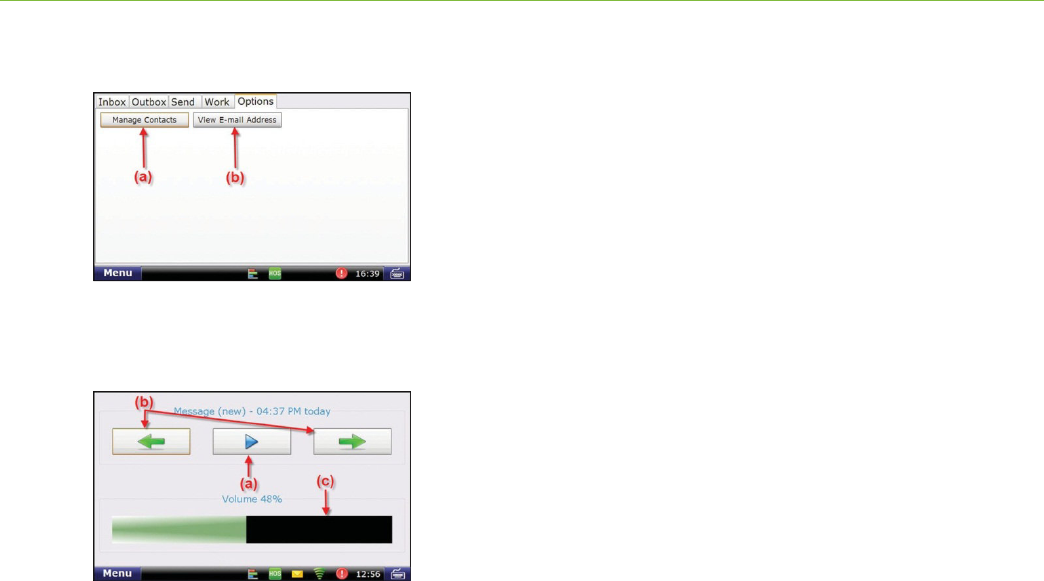
28
HD 100 Use
r
Manual
HD 100 Mail
Exhibit 14.
Options Tab
Exhibit 15.
Mail Safe-driving Screen
Options
The Options tab has two buttons [Exhibit 14].
Manage Contacts
[Exhibit 14, (a)]. This button lets you add
contacts (for the list that displays in the
To
drop-down box on your
Send message screen), request your contact list when you enter
a new truck and make changes to your contact list.
View E-mail Address
[Exhibit 14, (b)]. This button displays the
email address assigned to your HD 100 device.
Mail Safe-driving Screen
When you select the Mail icon while vehicle is in motion, the mail
safe-driving screen will appear. With the mail safe-driving screen
[Exhibit 15], you can hear a message rather than read it.
•
Play and stop messages [Exhibit 15, (a)].
•
Hear the previous or next message [Exhibit 15, (b)].
•
Control volume by dragging a finger across the volume box
[Exhibit 15, (c)].
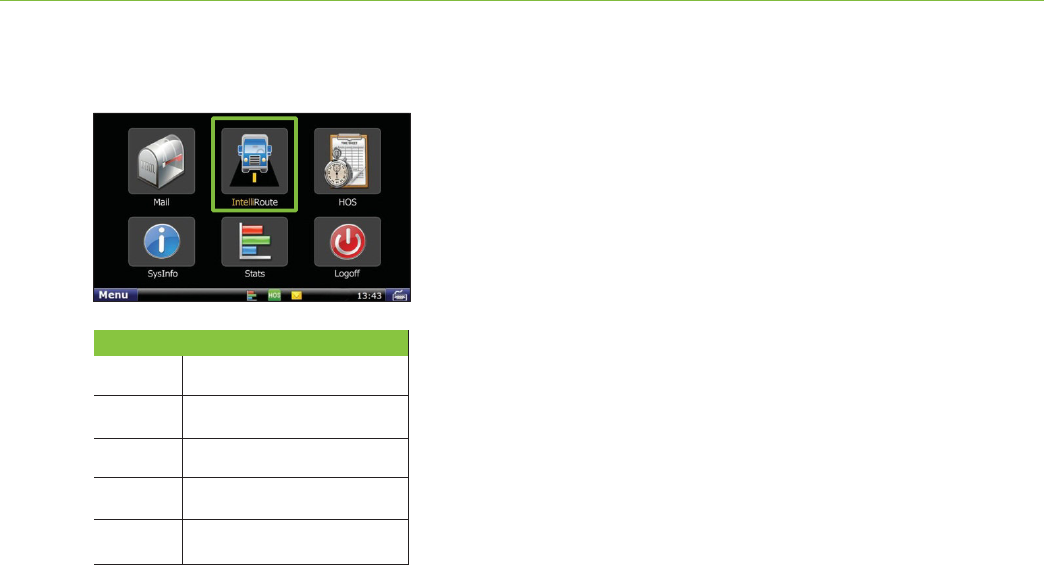
HD 100 Use
r
Manual
29
HD 100 Hou
r
s o
f
Service
Tab Function
Summary
Displays critical HOS information based
on your current duty status.
Logs
Displays list of duty statuses for the
current 8-day period.
DVIR
Allows you to enter and certify your
DVIRs for the current 8-day period.
Options
Allows you to manage log information and
settings related to violations and enforcement.
Company
Displays information related to your
carrier and terminal.
Exhibit 31.
HOS Icon on Home Menu
Hours of Service
With the HD 100 software, your HOS information is well-organized
and user-friendly.
What You Do
Mark the beginning of your day by submitting an On Duty status and
Trip Info entry. From that point on, the HD 100 device records Driving
and On Duty segments automatically. The only entries you need to submit
manually are Off Duty and Sleeper Berth statuses. When your day ends,
you can review and certify your logs—all in one streamlined process.
What the System Does
The HD 100 device logs all your HOS activities with accurate-to-the-
second technology so you can make the most of each day.
•
When you tap the
Trip Info
button, the 14-hour day officially begins.
•
When you begin driving after your pre-trip work is complete, Driving
status is activated as soon as the tractor detects motion.
•
When you stop, the system waits to be sure you have completed a
driving segment before marking the time and activating the On Duty
status. You do not need to worry about the system changing statuses
when you stop for traffic lights or signs.

30
HD 100 Use
r
Manual
HD 100 Hou
r
so
f
Service
Exhibit 32.
HOS Main Screen-Summary Tab
Summary
This tab gives you critical HOS information at-a-glance.
•
The top of the Summary tab shows the name and HOS status
of the driver logged into the HD 100 software [Exhibit 32, (a)].
If the driver shown is not you, log off then log back on.
•
The
Status Box
provides a summary of your current status
[Exhibit 32, (b)].
•
Screen left tells the time remaining before you reach HOS limits and
whether you can use the 16-hour rule [Exhibit 32, (c)]. Tap
the
(?)
button for details.
•
Screen right shows the time remaining before each type of reset
occurs [Exhibit 32, (d)].
-
70hr total.
Time until a new 70-hour log starts.
-
10hr Reset.
Time until a 10-hour reset.
-
Split Reset.
Time until reset with sleeper-berth
statuses calculated in.
NOTE:
The HD 100 device is compliant with FMCSA
regulation §395.15.
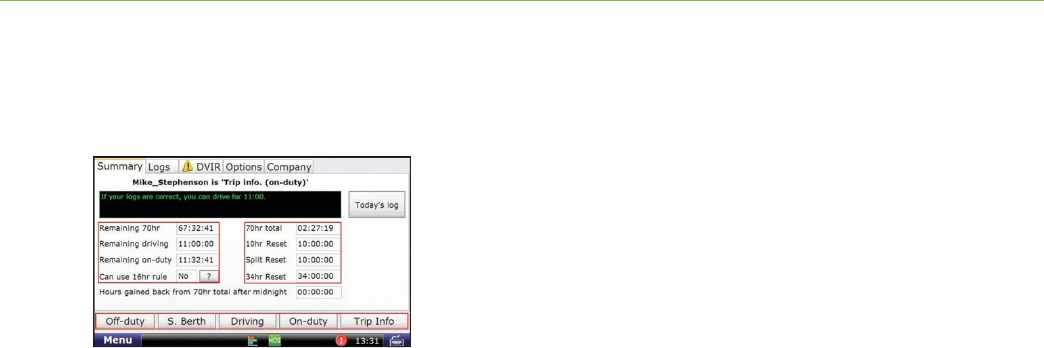
HD 100 Use
r
Manual
31
HD 100 Hou
r
s o
f
Service
Exhibit 32.
HOS Main Screen - Summary Tab
Summary (continued)
•
The Summary tab also reports
Hours gained back from
70hr total after midnight
[Exhibit 32, (e)].
Buttons at the bottom let you change your HOS status or
add specific trip information to the log [Exhibit 32, (f)].
The buttons display at the bottom of each HOS tab.
The
Today’s log
button accesses the graph and tabs you
need to manage your day [Exhibit 32, (g)].
The functions of adding a duty status, adding trip information
and managing the current day’s log are explained on the
following pages.
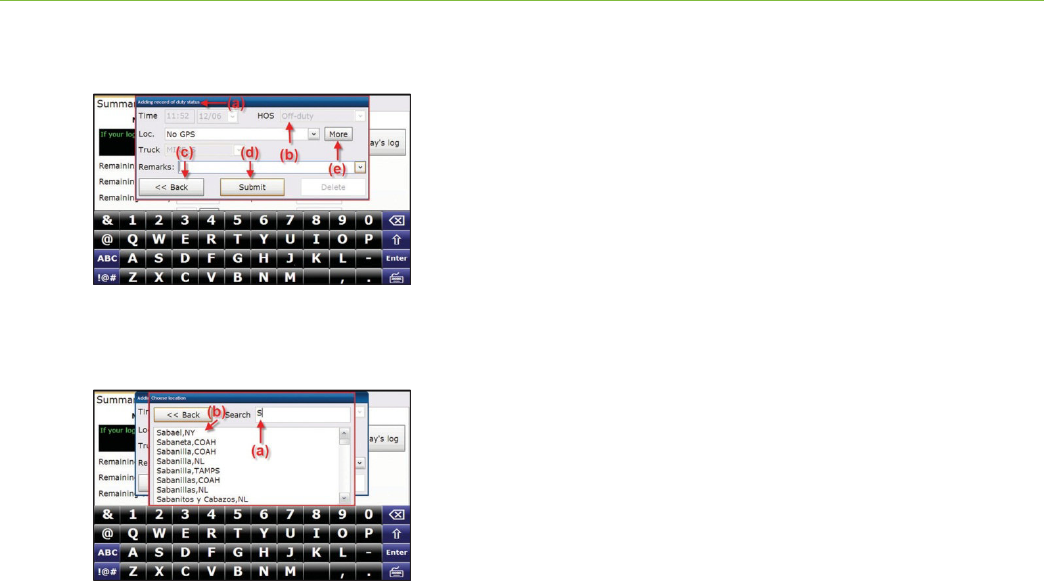
32
HD 100 Use
r
Manual
HD 100 Hou
r
so
f
Service
Exhibit 33.
Pop-up for Adding a Duty Status
Exhibit 34.
Pop-up for Choosing a Location
Add a Duty Status
•
Tap any duty-status button to view the [Exhibit 32, (f))
Adding
record of duty status
pop-up [Exhibit 33, (a)]. Most fields are
grayed out, which means you do not need to do anything; the
system records the required information automatically.
•
The pop-up shows the status selected [Exhibit 33, (b)].
For a different status, tap
Back
[Exhibit 33, (c)] and
select the status you want.
•
Tap
Submit
[Exhibit 33, (d)] if the record is correct.
•
If GPS is on, the
Loc.
field will be grayed out. If GPS is off, tap
More
[Exhibit 33, (e)] to view the
Choose location
pop-up [Exhibit 34].
Choose a Location
•
Begin typing your location in the
Search
box [Exhibit 34, (a)]
to bring up the section of the location list showing places
beginning with those letters [Exhibit 34, (b)].
•
Select your location to fill in the
Loc.
field.

HD 100 Use
r
Manual
33
HD 100 Hou
r
s o
f
Service
Exhibit 35.
Pop-up for Adding a Duty Status - Remarks Field
Add a Remark to a Duty Status
You may need to include a comment about your duty status.
The cursor automatically appears in the
Remarks
field
[Exhibit 35].
•
Use the drop-down arrow to view company-provided options.
•
If a standard remark applies, select it to fill in the field.
•
If a standard remark does not apply, type your own remark
using the on-screen keyboard.
•
Tap
Submit
to record the enhanced duty-status entry.

34
HD 100 Use
r
Manual
HD 100 Hou
r
so
f
Service
Exhibit 36.
Pop-up for Adding Trip Information
Add Trip Information
•
Tap the
Trip Info
button on the Summary tab to view
the
Adding trip information
pop-up [Exhibit 36, (a)].
The on-screen keyboard automatically appears so you can
enter
Load
,
Co-driver
(if appropriate),
Trailer
numbers
and
Remarks
.
•
The cursor appears in the active field. To move the cursor
to another field, just touch the field you want.
•
Standard remarks are included in the
Remarks
drop-down
[Exhibit 36, (b)]. Select the remark you want or use the
on-screen keyboard to enter a non-standard remark.
•
Tap
Submit
[Exhibit 36, (c)] to record your information and
return to the Summary tab. Tap
Back
[Exhibit 36, (d)] to return
to the Summary tab without recording your information.

HD 100 Use
r
Manual
35
HD 100 Hou
r
s o
f
Service
Exhibit 37.
Today’s Log Main Screen - Graph Tab
Today’s Log
The Today’s log button can be accessed on the Summary tab
[Exhibit 32, (g)]. Four tabs display across the top of the
Today’s log screen [Exhibit 37, (a)].
Graph
is the tab that opens when you select Today’s log. This screen
has three buttons:
Edit
,
Add Duty Status
and
Add Trip Info
.
•
Edit.
This button [Exhibit 37, (b)] allows you to edit any uncertified
log
from the last 8 days (select the arrow buttons
and
to
view a previous day’s log).
•
Add Duty Status.
This button [Exhibit 37, (c)] on the
Today’s Log
Graph
screen allows you to add a current duty status to the current
day. Any changes to earlier statuses must be made using the
Edit
button.
•
Add Trip Info.
This button [Exhibit 37, (d)] allows you to add infor-
mation for a new trip for the current day. Any changes
to the trip information for previous trips must be made using the
Edit
button.
NOTE:
Driving status time cannot be edited once recorded.

36
HD 100 Use
r
Manual
HD 100 Hou
r
so
f
Service
(a)
Exhibit 38.
Pop-up for Editing Trip Information
Edit Trip Information
Before selecting the
Edit
button [Exhibit 37, (b)], you can tap the
graph screen on the point where you would like to make an edit.
The green line on the graph indicates a change in duty status. You
can also tap the
Prev
and
Next
buttons to move the green line to
the desired point on the graph.
(e) (d)
(c)
Once you tap
Edit
, the Editing trip information pop-up will
appear [Exhibit 38, (a)]. Make any changes to the preexisting
information [Exhibit 38, (b)].
•
Tap
Delete
[Exhibit 38, (d)] if you wish to delete the
entire status entry.
•
Tap
Back
[Exhibit 38, (e)] to go back to the Graph tab.
•
Tap
Submit
[Exhibit 38, (c)] to save your entry.

HD 100 Use
r
Manual
37
HD 100 Hou
r
s o
f
Service
Exhibit 39.
Graph Tab - Day to be Certified
Certify Logs
•
If you have outstanding uncertified log entries (those that do not
have a check mark next to them), you should review and certify
them as soon as possible.
•
Uncertified log entries must be certified in order of
oldest to newest.
•
Review the entry using the tabs (Graph, List, Summary and
Trip Info) to verify that the log is accurate.
•
Make any required changes.
-
To change an incorrect status, select the correct status from
either the Graph or the List tab. Tap
Edit
[Exhibit 39, (b)]
to access the required pop-up. Make your changes and
tap
Submit
.
NOTE:
Driving status time cannot be edited once recorded.

38
HD 100 Use
r
Manual
HD 100 Hou
r
so
f
Service
Exhibit 39.
Graph Tab - Day to be Certified
Certify Logs (continued)
-To add a status, tap Add Duty Status [Exhibit 39, (c)].
Fill in the time, change the duty status field (if required) and
enter the location. Add Remarks if appropriate. Tap Submit.
-To alter the trip information record, tap
Add Trip Info
[Exhibit 39, (d)], fill in the form and tap
Submit
.
•
Once you are satisfied that the log is accurate, tap
Certify
[Exhibit 39, (e)]. A pop-up asks you to confirm the log is correct.
-Tap
No
to return to the previous screen.
-Tap
Yes
to return to the Logs tab.
When the log has been certified and recorded, a green check mark
appears at the beginning of the row.

HD 100 Use
r
Manual
39
HD 100 Hou
r
s o
f
Service
Exhibit 40.
Logs Tab
Logs
The Logs tab gives a summary of the totals for the last 8 days
[Exhibit 40]. Past days that you want to review, edit, or certify
are displayed.
•
The top of the tab lists your name and current HOS status
[Exhibit 40, (a)]. If you are not the driver shown, log off
the HD 100 software, then log back on.
•
The columns on this tab show summary information
about each day’s log.
-
Date.
Displays the last eight days with the current date at
the top of the list.
-
Miles.
States the number of miles traveled for the day.
-
Off-duty.
Gives the number of off-duty hours logged for the day.
-
S.B.
Indicates the time spent in the sleeper berth for the day.
-
Driving.
Gives the time spent driving for the day.
-
On-duty.
Gives the time spent on-duty but not driving for the day.
•
The check marks to the left of the
date
column show which days
have been certified [Exhibit 40, (b)].
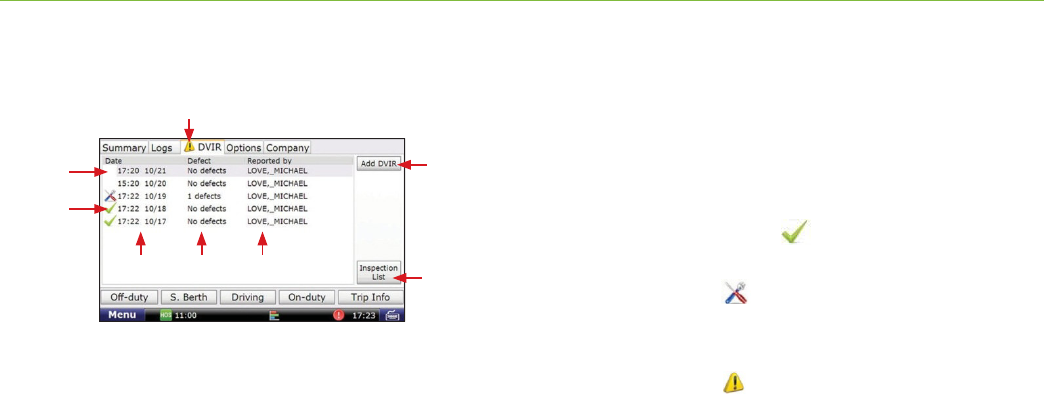
HD 100 Hou
r
so
f
Service
40
HD 100 Use
r
Manual
(a)
(b)
Exhibit 41.
DVIR Tab
(c)
(d)
(e) (f)
(g)
(h)
DVIR
The DVIR (Daily Vehicle Inspection Report) tab contains information
regarding all DVIR entries from the last 8 days.
DVIR information is clustered together [Exhibit 41, (a), (b) and (c)].
(a)
. A blank space in this column means the DVIR entry has not
yet been certified.
(b)
. A green check mark ( ) means the DVIR has been
certified.
A tool icon (
) means a DVIR entry has been added
and
that there is an outstanding defect that should be
reviewed
and certified.
(c)
. A warning icon ( ) on the DVIR tab means there is an
outstanding defect.
(d)
. This column tells you when the DVIR entry was made.
•
The time and date are listed.
(e)
. This column tells you the number of defects listed
in the DVIR entry.
(f)
. This column tells you the Driver ID of the person who
added the DVIR entry.
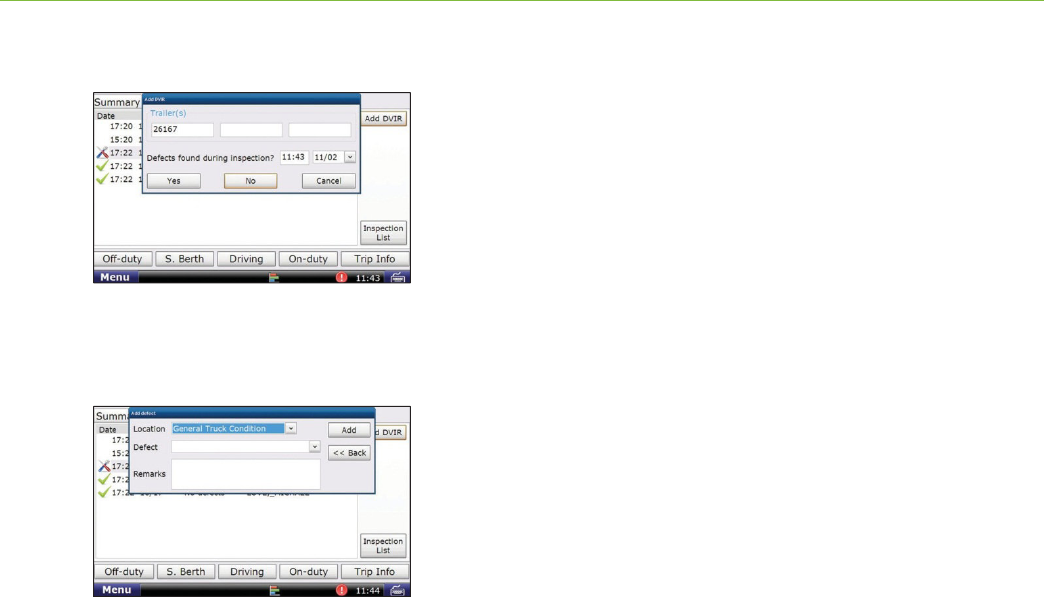
HD 100 Hou
r
s o
f
Service
HD 100 Use
r
Manual
41
Exhibit 42.
Pop-up for Adding DVIR
Exhibit 43.
Pop-up for Adding Defect
Add a DVIR
•
Add DVIR
. Use this button when you want to add a DVIR
for the current day or for any day within the last 8 days
[Exhibit 41, (g)].
-
Trailer(s)
.
-
Time
and
Date
.
You may have to enter defects from your inspection.
If so, select
Yes
[Exhibit 42].
-
Enter the Location and Defect fields [Exhibit 43]
-
You can also add other notes about the inspection
in the Remarks field.
NOTE:
You can also view this screen by selecting any DVIR entry
from the past 8 days on the DVIR main screen. This will allow you
to add a defect to a previous day’s DVIR.

HD 100 Hou
r
so
f
Service
42
HD 100 Use
r
Manual
Exhibit 44.
DVIR Record-Defects Tab
Certify DVIR Entries and Repairs
To review the entered defects of previous DVIR entries, select
any entry from the last 8 days on the DVIR tab [Exhibit 40].
-
Defects
tab [Exhibit 44].
Select this tab to view the description of each defect listed for
the selected DVIR. Click on any of the defect entries to view any
entered remarks.

HD 100 Hou
r
s o
f
Service
HD 100 Use
r
Manual
43
Exhibit 45.
DVIR Record - Certify Tab
Certify DVIR Entries and Repairs (continued)
-
Certify
tab [Exhibit 45].
Select this tab to certify the DVIR entry.
•
Reported by: lists Driver ID and time and date of DVIR entry.
•
Repaired by: lists Driver ID and time and date of repair.
-
Tap
No repairs needed
.
-
Tap
Repairs Made
to indicate that defects have
been repaired.
Note
: You must select one of these options in order to
certify your DVIR.
•
Review:
-
Tap
Certify
to submit the DVIR.
As with other HOS screens, you can update your current status with
the buttons at the bottom [Exhibit 40].

HD 100 Hou
r
so
f
Service
44
HD 100 Use
r
Manual
Exhibit 46.
Options Tab
The Options tab allows you to:
Request Logs
. Use this button when you want to move your
logs from a previous tractor or when you have previous logs that
you cannot view. The button brings up a pop-up box that displays
the following notice:
“Those portions of your log that haven’t been received by
the back-end may be deleted when your HOS logs are
downloaded.”
-
You choose whether to continue (
Yes
) or to cancel
the request (
No
).
Change Trucks
. Use this button before you move to another
tractor to confirm for yourself that your logs are sent to the server
and will be available for you when you log on in the new truck
(you may need to use
Request Logs
on the new truck, but
usually the logs arrive as you log in).

HD 100 Hou
r
s o
f
Service
HD 100 Use
r
Manual
45
Exhibit 46.
Options Tab
Options (continued)
Fax/E-mail Logs
. Use this button to fax or e-mail your logs.
Select to send logs by Email or Fax, enter the email address or fax
number of the law enforcement official, and tap
Send
.
Note:
You cannot send your logs unless you have certified all logs
from the last 8 days, and you must be in Roadside Audit Mode. Be
sure to enter the email address or fax number correctly, as you must
wait 10 minutes before sending your logs again.
View Violations
. Use this button to review any violations that are
currently part of your weekly log.
-
The screen shows the type of violation, the time and
date the violation began, and the time and date the
violation ended.
-
If you have multiple violations on the same day, each
driving segment is its own violation. However, violations on
the same day count as a single violation for the day.

HD 100 Hou
r
so
f
Service
46
HD 100 Use
r
Manual
Exhibit 47.
Pop-up for Changing Mode
Options (continued)
Change Mode
. This button lets you govern the information
displayed within the HD 100 software.
-
Normal.
This option is the default or standard working mode.
-
Roadside Audit.
This option provides limited access to your logs
when enforcement asks to see them. No additional information
is shown except what is required by law. No log information can be
changed by you or enforcement while you are in Roadside
Audit mode.
•
Tap
Normal
to exit Roadside Audit mode.
- Enter your
Driver ID
.
-
Personal Conveyance.
This option lets you use your vehicle for
personal use. Use this mode only when your vehicle is not laden.
You must also be Off Duty first before you can enter Personal
Conveyance Mode.
As with other HOS screens, you can update your current status
with the buttons at the bottom [Exhibit 46, (b)].

HD 100 Hou
r
s o
f
Service
HD 100 Use
r
Manual
47
Exhibit 48.
Company Tab
Company
The Company tab [Exhibit 48] contains information required for
your log. If any of the information is incorrect, please refer to the
Connect Web Portal User Manual (Help > Connect Help >
[Management > System Settings > Company Settings])
Carrier
The upper half of the screen identifies your carrier
[Exhibit 48, (a)].
-
Name.
-
Address.
-
DOT number.
Terminal
The lower half of the screen identifies the home terminal to which
the HD 100 is assigned [Exhibit 48, (b)].
-
Name.
-
Address.
- Start.
This field shows the time and time zone for the terminal,
which governs the HOS information captured by the unit.

HD 100 Hou
r
so
f
Service
48
HD 100 Use
r
Manual
Exhibit 49.
HOS Safe-driving Screen
HOS Safe-driving Screen
The time shown on the HOS safe-driving screen is the effective
drive time available to you for the day [Exhibit 49]. The time
indicates how long you can drive before going into any violation, so
the time displayed may not be your actual available drive time if you
are close to your 14 or 70-hour limit.
Time.
Two numbers appear for your remaining drive time if the
16-hour rule is active.
Color.
Color coding lets you closely monitor your HOS statuses and
take whatever action is necessary to remain
in compliance.
When vehicles are in compliance with HOS limits, the
time displays in
green
.
When a vehicle is within one hour of the legal limit for
any HOS requirement, the display changes to
yellow
.
When a vehicle is out of time for any HOS requirement,
the display changes to
red
.
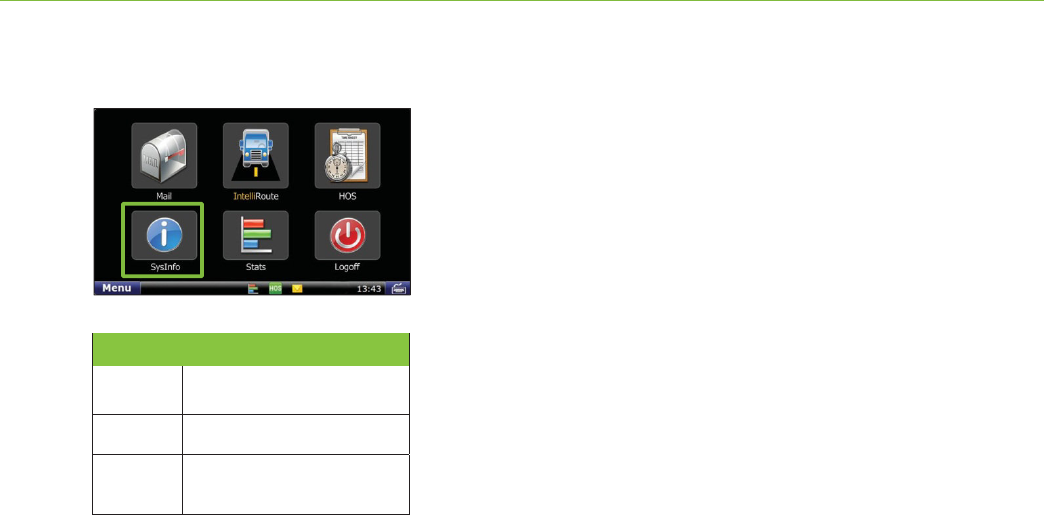
HD 100 Use
r
Manual
49
HD 100 SysInfo
Exhibit 50.
SysInfo Icon on Home Menu
SysInfo
Select the
SysInfo
icon on the Home Menu [Exhibit 50] to
control system settings and to view technical information
about your HD 100 device.
SysInfo opens to the Settings tab. The tabs in SysInfo are explained
in the table to the left.
Tab Function
Settings
Allows you to control the volume and
screen brightness.
Info
Displays system information.
Diagnostics
Displays information related to your
HD 100's communication status.
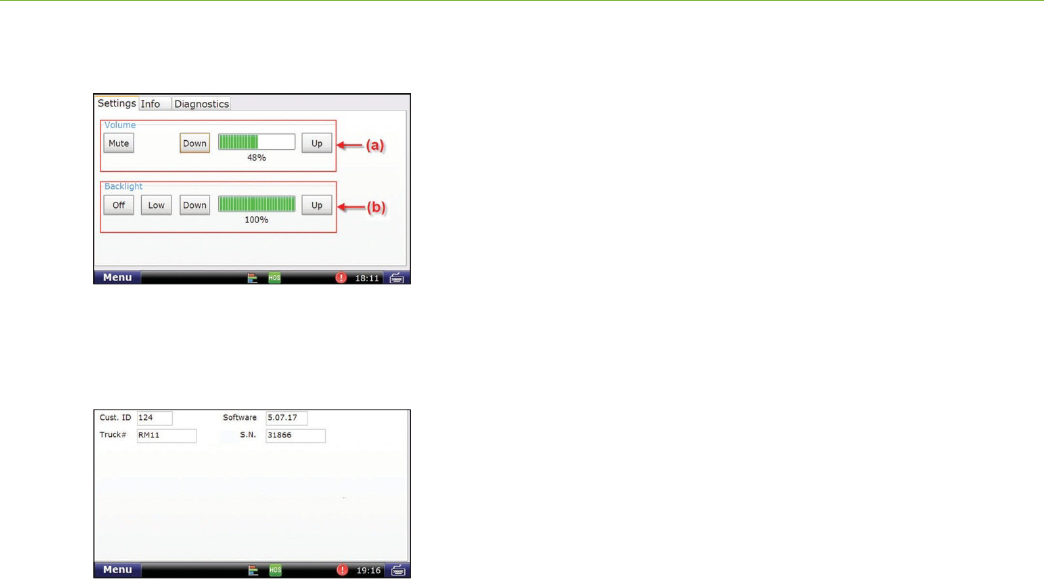
50
HD 100 Use
r
Manual
HD 100 SysInfo
Exhibit 51.
Settings Tab
Exhibit 52.
Info Tab
Settings
Volume.
Control the volume of your in-cab device by selecting
Mute
or by tapping the
Down
and
Up
buttons [Exhibit 51, (a)]. Each tap
changes the volume by 10 percent. You can also change the volume by
pressing down and drawing your finger across the percentage box.
Backlight.
Control the backlight by selecting
Off
or by adjusting the
screen’s brightness by tapping the
Down
and
Up
buttons [Exhibit 51,
(b)]. You can also press down and draw your finger across the
percentage box.
Low
dims the screen to less than 10 percent.
Info
Tap
Info
to access registration information for your HD 100.
The fields on the tab window include Cust. ID. (Customer Number),
Software
Version,
Truck #
and
S.N.
(Serial Number).
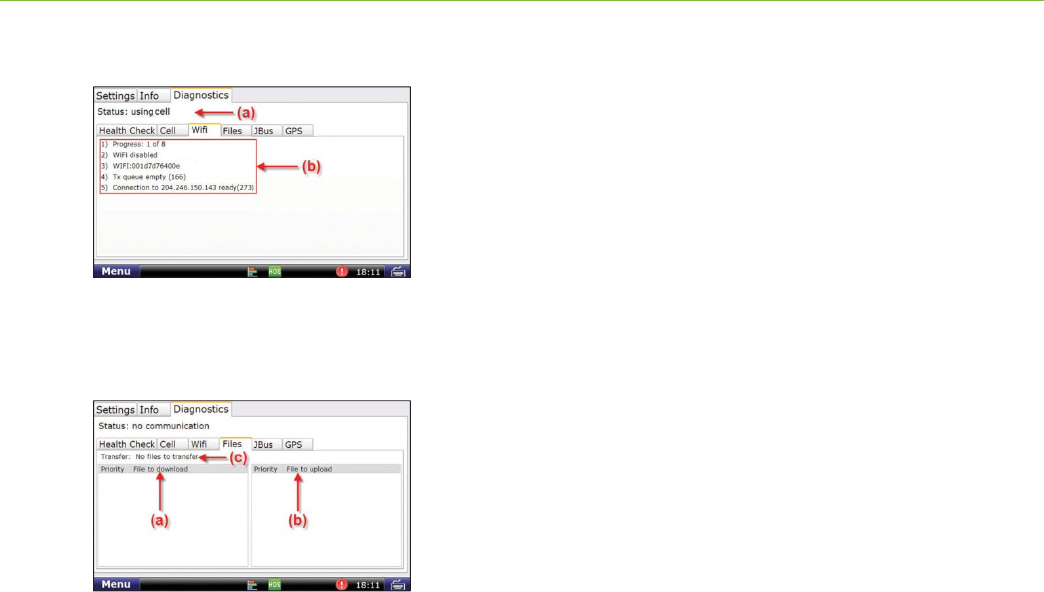
HD 100 Use
r
Manual
51
HD 100 SysInfo
Exhibit 53.
Diagnostics – Wi-Fi Sub-Tab
Exhibit 54.
Diagnostics – Files Sub-Tab
Diagnostics
Status.
Shows the current method of communication
[Exhibit 53, (a)].
Health Check.
Confirms function of system hardware.
Cell.
Provides status of cell connection.
Wi-Fi.
Provides status of Wi-Fi connection
[Exhibit 53, (a) and (b)].
Files.
Shows files scheduled for download or upload [Exhibit 54].
-
Downloads to the truck [Exhibit 54, (a)] can include
software updates and dispatch files.
-
Transfer [Exhibit 54, (c)] provides the current status of the
file being transferred. If you are expecting a software update, you
can look here to see the status of that download. The percentage
shown indicates how much of the file has been received.
JBus.
Confirms connection to on-board computer.
GPS.
Captures latitude, longitude, altitude, speed, direction and
provides debug information for the GPS.

52
HD 100 Use
r
Manual
HD 100 SysInfo
Exhibit 55.
SysInfo Safe-driving Screen
SysInfo Safe-driving Screen
The SysInfo safe-driving screen allows you to adjust your
TND
™
720’s volume and screen brightness [Exhibit 55].
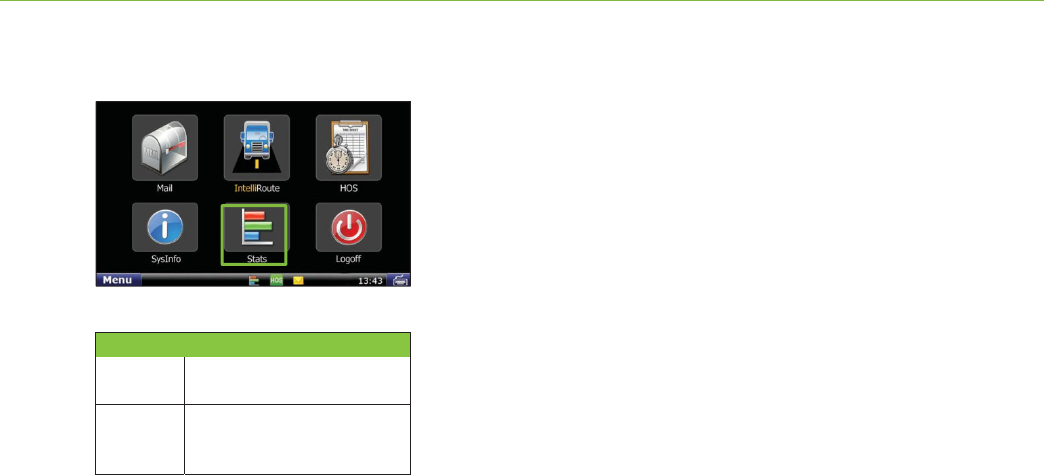
HD 100 Use
r
Manual
53
HD 100 Stats
Exhibit 56.
Stats Icon on Home Menu
Stats
Select the
Stats
icon on the Home Menu [Exhibit 56] to access
information about driver performance and fault codes.
Stats opens to the Driver Performance tab. The tabs in
stats are explained in the table to the left.
Tab Function
Driver
Performance
Displays statistics based on idle time, RPM,
engine and motion time.
Fau lt C od es
Displays fault codes and the location and type
of fault in relation to your vehicle.

54
HD 100 Use
r
Manual
HD 100 Stats
Exhibit 57.
Driver Performance Tab
Driver Performance
The
Driver Performance
tab displays these statistics:
Hard brakes— where vehicle speed is over 20MPH.
Miles / MPG.
Idling percentages for Short, Mid and Long Idles.
Over Idle %—where idle is over your fleet’s grace period.
Over RPM%.
Speeding%.
You can tap the
Show more metrics for today
button
[Exhibit 57, (b)] to view a pop-up with information on
Idle fuel, Stop Idle %, Total Idle %, Driving %, Engine time
and Motion time.
You can tap the
Request metrics for month
button
[Exhibit 57, (c)] to receive an update on driver performance.
The report includes month-to-date information.

HD 100 Stats
HD 100 Use
r
Manual
55
Exhibit 58.
Fault Codes Tab
Fault Codes
The
Fault Codes
tab [Exhibit 58, (a)] displays
recorded fault codes for the vehicle.
Two columns provide details about the fault
[Exhibit 58, (b)].
Source.
Indentifies the location of the fault
(e.g., engine, cab controller, etc.).
Subsystem/Parameter.
Identifies the type of fault.

56
HD 100 Use
r
Manual
Help Resources
Rand McNally provides you with various how-to documents and media
for both the HD 100 device and the Connect web portal.
User Documentation
(These items are included in your HD 100 box)
HD 100 User Manual
This document gives you instruction on how to activate and install
your HD 100 the first time, as well as how to use the HD 100 device
software. Keep this document in your truck for future reference.
Rand McNally Hours of Service Visor Card
This visor card gives you instruction on the HD 100 Hours of Service
application and what to do during a roadside inspection. Keep this
document in your truck at all times.
Additional Resources
(These items can be accessed in the Connect
web portal)
Connect Web Portal
While you are using the portal, you can refer to the Connect web
portal User Manual. Select the Help tab, then click Connect Help. The
User Manual will open in a new tab in your browser.
If you would like to save the Connect web portal User Manual to your
computer or print it out, click Download PDF or Print.
Where to access: Help > Connect Help
Training Videos
Rand McNally offers various instructional videos on how to use the HD
100 device software, such as the Hours of Service application.
Where to access: Help > Training > Training Videos
User Documentation
If you lose the user documentation that is included in your HD 100
box or if you would like additional copies, you can save or print these
items. This includes documents such as the HD 100 User Manual and
Rand McNally Hours of Service Visor Card.
Where to access: Help > Training > User Documentation
Customer Support
If, after reviewing the documentation above, you still have questions
regarding how to activate or install our HD 100 or how to use the de-
vice or Connect web portal, please contact Rand McNally’s Customer
Support team.

HD 100 Use
r
Manual
57
Help Resources
Call us:
1-800-641-RAND (7263)
Email us:
fleetsupport@randmcnally.com
Write to us:
Rand McNally
Attn:
HD 100
Customer
Support
9855
Woods Drive
Skokie, IL 60077
58
HD 100 Use
r
Manual
Rand McNally follows a continuous improvement process
and reserves the right to provide enhancements that may not
be reflected in the pictures and specifications of this manual.
Rand McNally and IntelliRoute are registered trademarks and TND is a trademark of Rand McNally.
The Trucker’s Friend and National Truck Stop Directory are registered trademarks of TR information Publishers,
Truck Down is a registered trademark of TruckDown Info International, Inc.
NAVTEQ ON BOARD is a trademark of NAVTEQ ©NAVTEQ. All rights reserved.
©2013 Rand McNally. All rights reserved.
While the information contained herein is believed correct when compiled, Rand McNally does not
guarantee its accuracy.
U.S. Patent No. 7,580,791
HD 100 Use
r
Manual
59

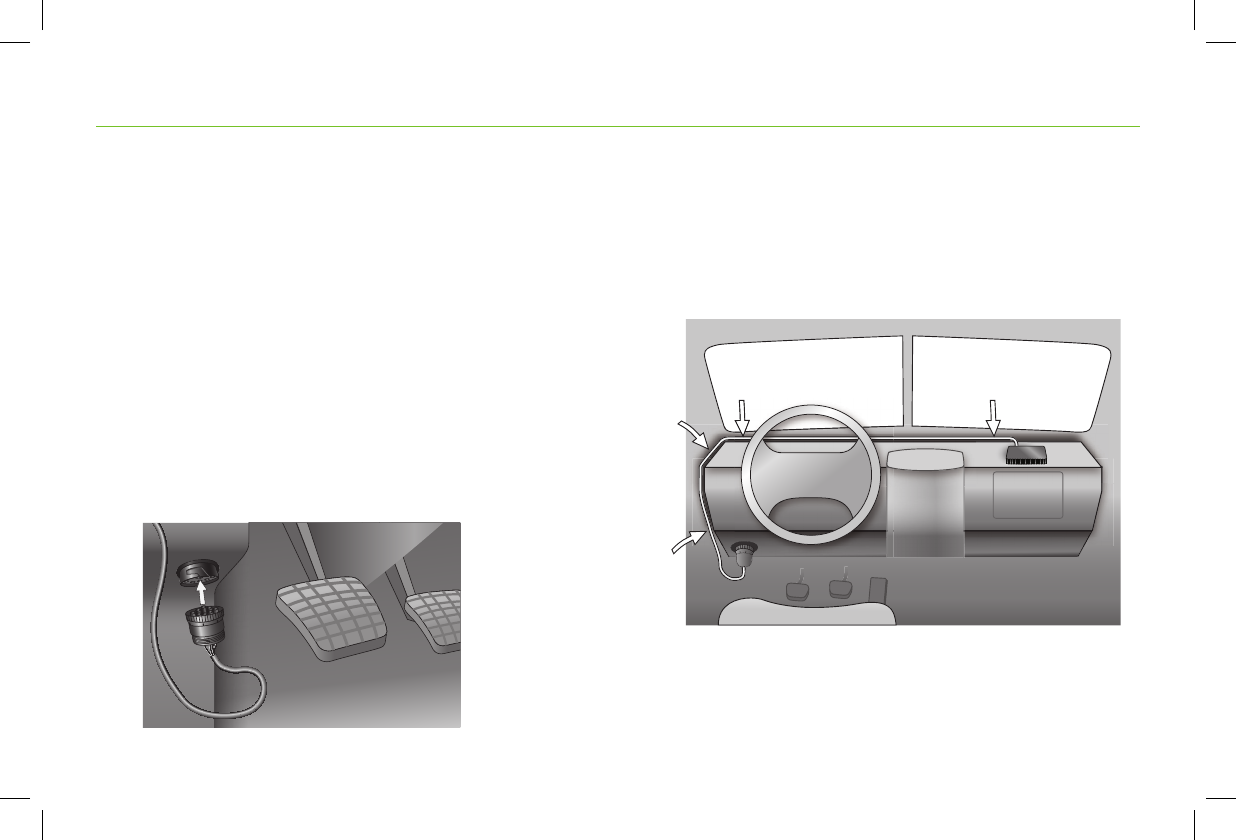
8HD 100 User Manual
Installing Your HD 100 > Installation Instructions
Installing your HD 100 can take as little as 10 minutes. Install
instructions are provided here, as well as quick diagnostic
information so you can make sure your device is working correctly.
Installation Instructions
1.
windshield and the dash.
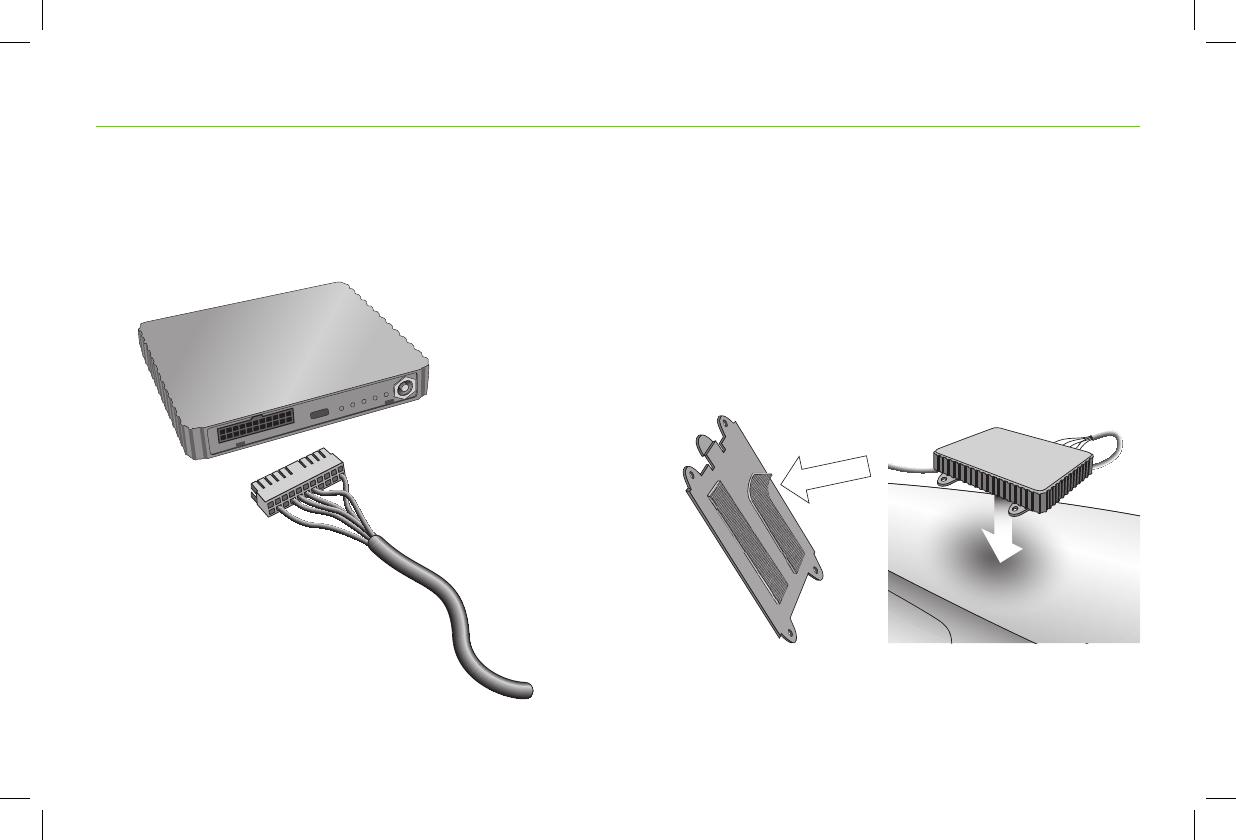
9
HD 100 User Manual
3.
device face away from you so as to not distract while driving.
Installing Your HD 100 > Installation Instructions
4. Make sure the area where you would like to place your HD 100
100 tray, then peel the other protective layer and place the
device with tray attached on your dash in the desired location,
pressing firmly to secure it to the dash surface.
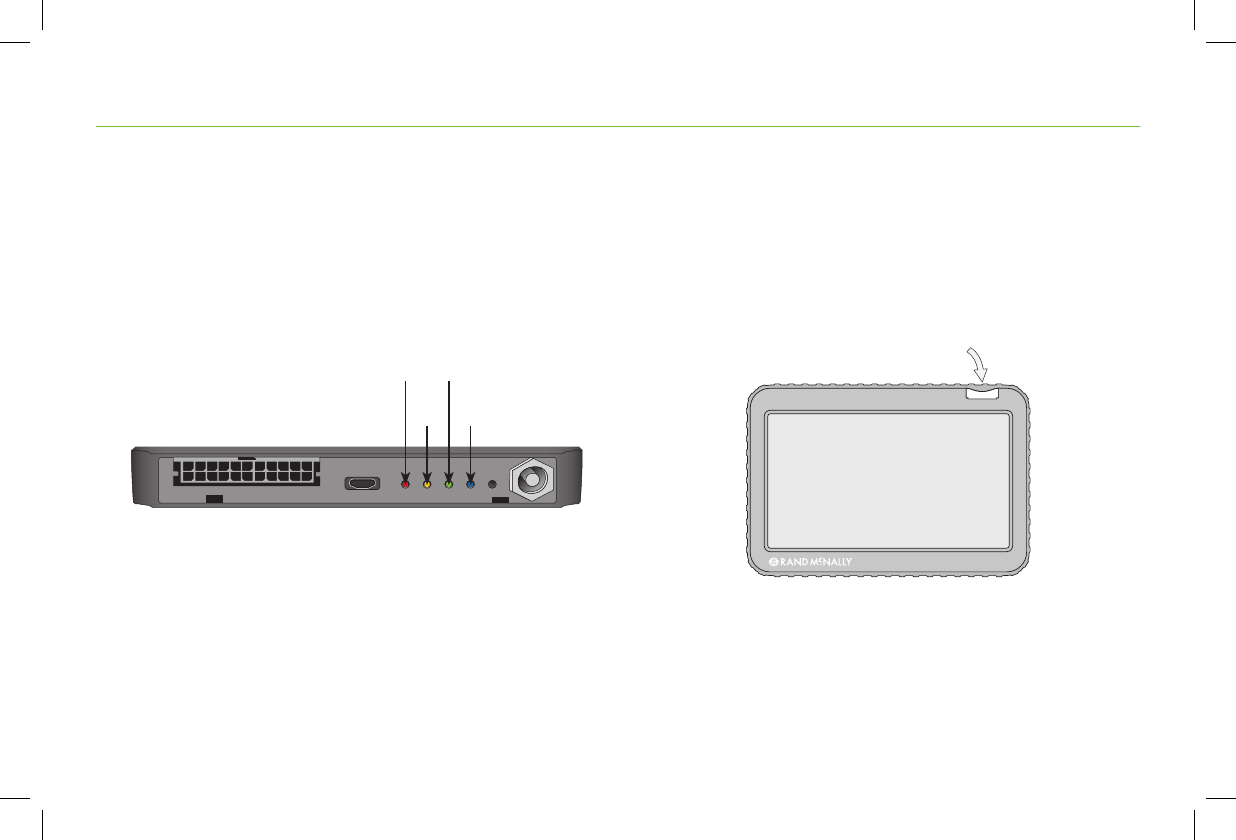
10 HD 100 User Manual
Installing Your HD 100 > Installation Instructions
5. Once the HD 100 is installed and connected to vehicle with
to ensure the device is connected and running properly
6. ™
®
on this screen.
™
™
in use with the HD 100.
7.
Driver ID you created when activating your device through
™
is in this email for your records.
Power Button
Power
(Red)
Wi-Fi
(Yellow)
Cell
(Green)
JBus
(Blue)
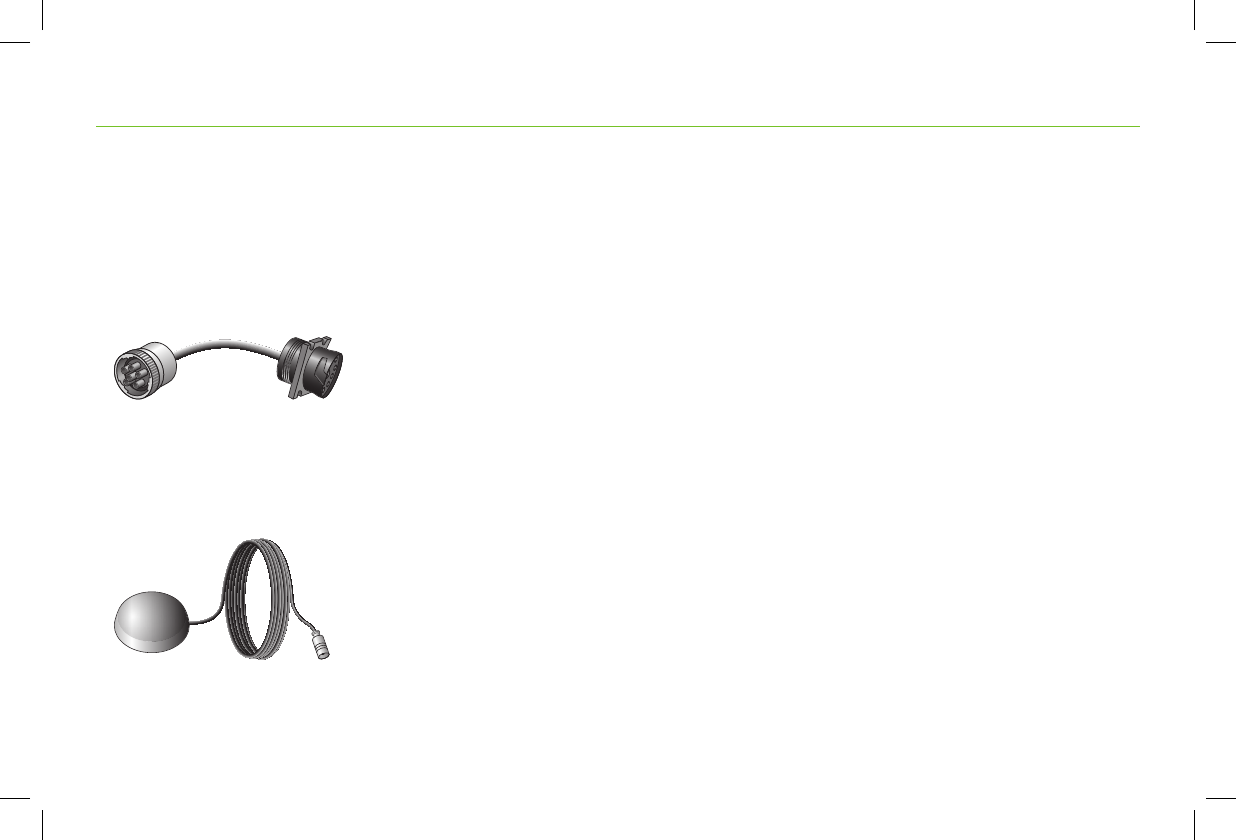
11
HD 100 User Manual
Installing Your HD 100 > Alternative Installation Options
Alternative Installation Options
purchased at randmcnally.com/fleetaccessories.
9- to 6-pin Cable Adapter
External antenna
1-800-641-RAND (7263)
or fleetsupport@randmcnally.com for more information on
alternative installation options.
randmcnally.com/HD100installation.

12 HD 100 User Manual
™
Quick Diagnostics
Verify HD 100 Connectivity
Verify GPS Communication
Verify J1708/1939 Communication
there is a value in the Miles field on the second line in the first column.
Send Test Message
corner. Make sure message indicator changes from a red X icon
to a green check mark icon
Installing Your HD 100 > Quick Diagnostics
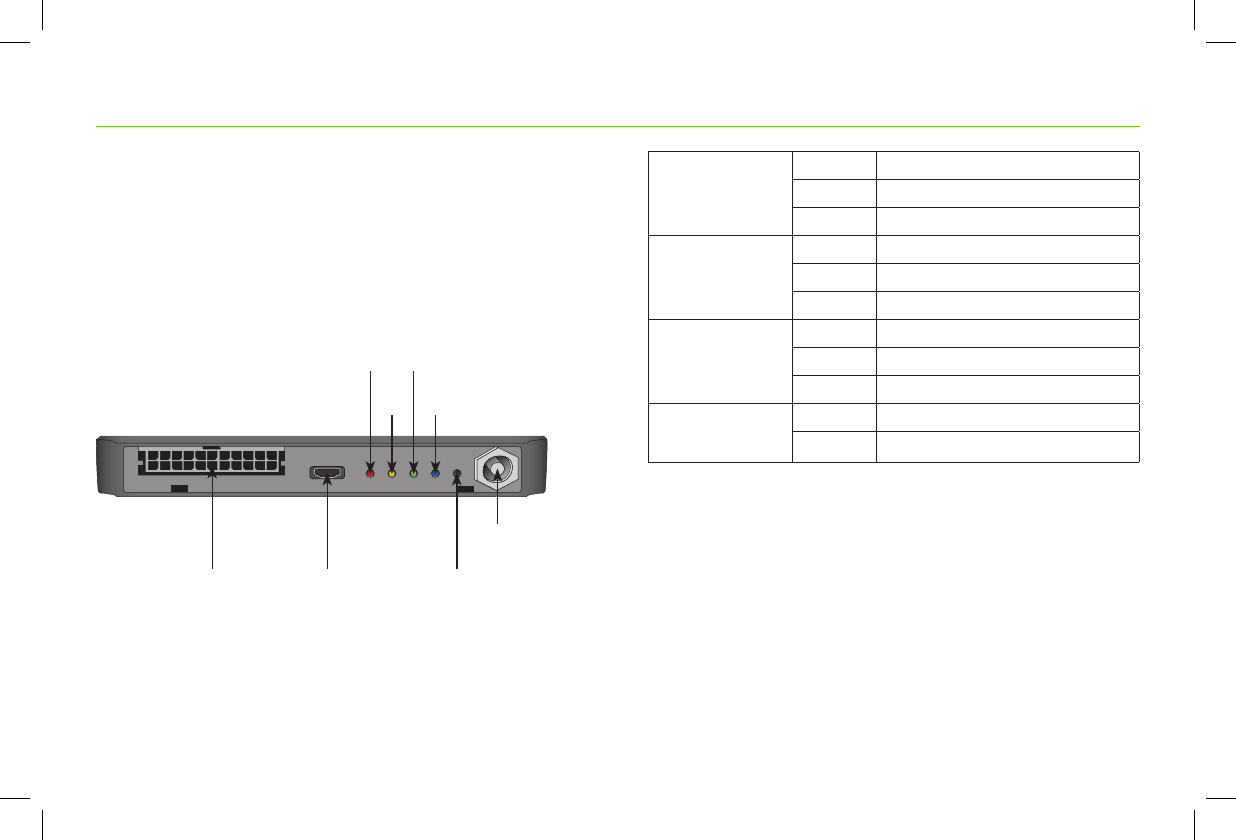
13
HD 100 User Manual
compliance system is not functioning properly.
device is connected and running properly. If one or more of the four
lights are not illuminated, meaning they are either off or flashing,
Power
(Red)
On
Flashing
Off
Wi-Fi®
(Yellow)
On
Flashing
Off
Cell
(Green)
On
Flashing
Off
JBus
(Blue)
On
Off
Installing Your HD 100 > Troubleshooting Tips
Power
(Red)
Wi-Fi
(Yellow)
Cell
(Green)
JBus
(Blue)
Power
Port
Mini-USB
Port
Reset
Button
External
Antenna
Port*

14 HD 100 User Manual
No power or intermittent power loss:
Check power connection
on, which indicates the device is powered on.
Check communications
illuminated which indicate the device is connected and running
Wi-FiYellow, CellGreen, JbusBlue
Unable to connect Cell or Wi-Fi®:
Restart the device
Check communications
Move the truck to ensure that the issue is not signal interference.
Installing Your HD 100 > Troubleshooting Tips

15
HD 100 User Manual
Installing Your HD 100 > Troubleshooting Tips
Nothing appears on TND™ 720 screen:
Make sure your TND™ 720 is charged and powered on.
Check communications
Move the truck to ensure that the issue is not signal interference.
Check power connection
on, which indicates the device is powered on.
Restart the device
™
™
JBus not responding:
Make sure truck ignition is on
Restart the engine
Restart the device